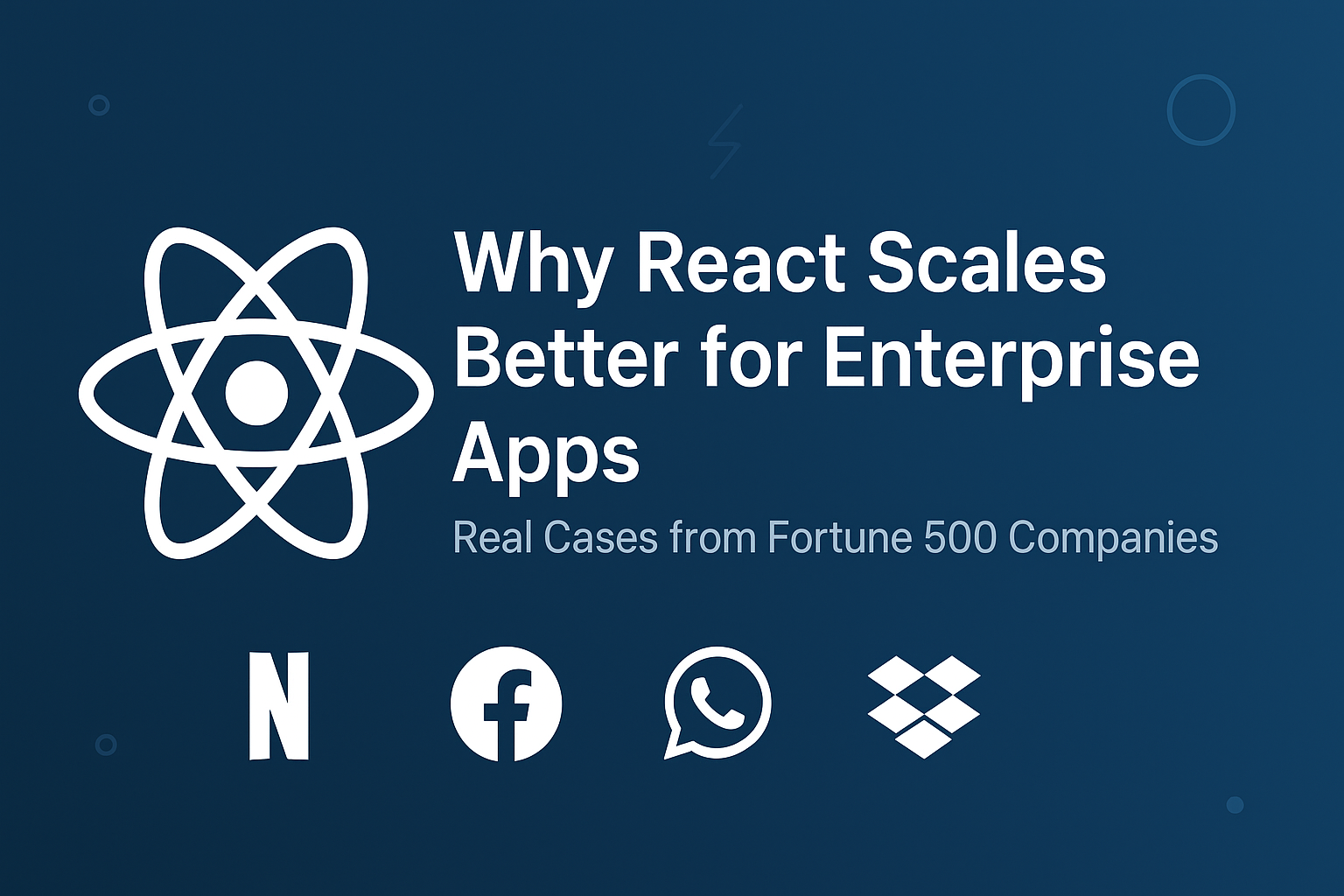Over 40% of developers worldwide choose React for enterprise applications, making it the second most popular web framework in this space.
The statistics become even more compelling when we consider developer satisfaction: 68.9% of React developers enjoy working with this library and plan to continue using it.
So, what’s driving this widespread adoption? The answer lies in React’s component-based architecture and flexibility, which make it a natural fit for enterprise-scale applications. This approach enables faster UI creation, efficient data handling, and the reusability of components—exactly what large-scale businesses need.
Major brands like Netflix, Facebook, and Instagram have built their platforms around React, alongside Dropbox, Codecademy, WhatsApp, and Khan Academy.
But beyond the big names, the real question is:
Does React actually solve enterprise-scale challenges?
Let’s explore why React scales better for enterprise apps and see how Fortune 500 companies have proven its value in real-world environments.
Why React Fits Enterprise Application Frameworks
React is not a full-stack framework—it’s a library focused solely on building user interfaces. That distinction matters.
Unlike traditional frameworks with rigid, opinionated structures, React leaves architectural decisions to the development team. For enterprise projects—where requirements can vary widely—this flexibility is crucial.
This means businesses can design applications around their unique needs, instead of forcing their workflows to fit into a predefined framework pattern.
Component-Based Architecture for Modular Development
React’s component-based structure breaks down complex UIs into smaller, reusable parts. For enterprise development, this offers clear advantages:
- Improved maintainability: Update components without affecting the whole system
- Reusability: Use the same component across multiple areas or even projects
- Separation of concerns: Isolate business logic from presentation layers
- Lower cognitive load: Teams can focus on one feature at a time
For fast-changing enterprise environments, this modular approach means faster iteration without sacrificing stability—a competitive advantage in any market.
JSX and Virtual DOM for Efficient Rendering
React’s JSX syntax makes UI code more readable and maintainable, blending HTML-like structures directly in JavaScript.
The Virtual DOM is where React’s performance magic happens:
- React creates a lightweight, in-memory representation of the DOM
- It compares (diffs) the new version with the old
- It updates only the parts that changed
This selective rendering keeps applications fast and responsive—even when handling large datasets or real-time updates, both of which are common in enterprise systems.
Unidirectional Data Flow for Predictable State Management
React enforces one-way data flow, meaning data moves from parent components to children. This leads to:
- Predictable behavior for easier debugging
- Centralized state management via tools like Redux
- Clear separation of responsibilities between logic and presentation
For enterprises, Redux and Context API provide scalable state solutions that keep even massive applications organized and easy to maintain.
Scalability Features That Make React Enterprise-Ready
1. Code Reusability Through Shared Components
Shared UI libraries allow enterprises to standardize design and functionality across apps, reducing duplication and improving consistency.
2. Micro-Frontend Support
React works well with micro-frontends, enabling large teams to work independently on separate app modules without stepping on each other’s toes.
3. Flexible State Management
From Context API for smaller apps to Redux for large-scale systems, React offers multiple ways to scale state handling as complexity grows.
Real-World Use Cases from Fortune 500 Companies
Facebook – Gradual Migration from PHP
Instead of a complete rewrite, Facebook incrementally replaced UI sections with React components, reducing risk and improving performance without downtime.
Netflix – Optimizing for Diverse Devices
Netflix uses a custom React version (“React-Gibbon”) to keep performance high on everything from smart TVs to low-powered devices, focusing on startup speed and memory efficiency.
New York Times – Data-Driven Interactive UIs
React enabled the Times to create a dynamic Oscars archive with instant filtering, something their previous tech stack struggled to handle.
Dropbox & WhatsApp Web – Consistency Across Platforms
Both use React to maintain uniform user experiences across web, mobile, and desktop environments, critical for brand consistency.
SEO and Performance Benefits for Enterprises
React alone struggles with SEO due to client-side rendering, but Next.js solves this with server-side rendering (SSR):
- Faster initial page loads
- Better search engine indexing
- Improved user experience on slow networks
Enterprise-grade apps also benefit from 40% faster First Contentful Paint times with SSR compared to purely client-side apps.
Cross-Platform Development Advantages
With React Native, enterprises can share business logic between web and mobile apps, often achieving 90%+ code reuse.
Benefits include:
- Faster time-to-market
- Lower development costs
- Consistent functionality across all platforms
Conclusion
React’s success in the enterprise world isn’t accidental—it’s the result of flexibility, performance, and scalability.
From Facebook’s incremental migration to Netflix’s device-agnostic optimization, Fortune 500 companies prove React can handle millions of users, high data loads, and rapid feature updates without compromising stability.
For enterprises aiming to build future-proof applications that scale across teams, devices, and platforms, React remains one of the most strategic choices available today.
Key Takeaways:
- Component-based architecture saves 30–50% in long-term dev costs
- Virtual DOM boosts load times by up to 40%
- Next.js SSR solves SEO issues for public-facing apps
- Fortune 500 case studies prove React’s scalability in real-world scenarios
- Cross-platform code sharing speeds delivery by 30–40%



